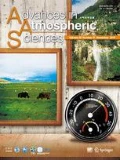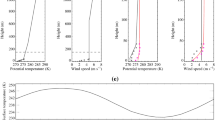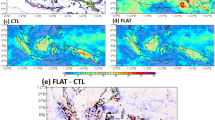Abstract
This paper presents a high-resolution simulation of a remarkable polar low observed over the Sea of Japan on 21 January 1997 by using a 5-km mesh non-hydrostatic model MRI-NHM (Meteorological Research Institute Non-Hydrostatic Model). A 24-hour simulation starting from 0000 UTC 21 January 1997 successfully reproduced the observed features of the polar low such as the wrapping of western part of an initial E-W orientation vortex, the spiral-shaped bands, the cloud-free “eye”, and the warm core structure at its mature stage. The “eye” of the simulated polar low was relatively dry, and was associated with a strong downdraft. A thermodynamic budget analysis indicates that the “warm core” in the “eye” region was mainly caused by the adiabatic warming associated with the downdraft. The relationship among the condensational diabatic heating, the vertical velocity, the convergence of the moisture flux, and the circulation averaged within a 50 km×50 km square area around the polar low center shows that they form a positive feedback loop, and this loop is not inconsistent with the CISK (Conditional Instability of the Second Kind) mechanism during the developing stage of the polar low.
Similar content being viewed by others
References
Anthes, R. A., 1982: Tropical cyclones: Their evolution, structure and effects.Meteor. Monogr.,19, Amer. Meteor. Soc., 208pp.
Charney, J. G., and A. Eliassen, 1964: On the growth of the hurricane depression.J. Atmos. Sci.,21, 68–75.
Fu Gang, 1999: An observational and numerical study on polar lows over, the Japan Sea. Ph. D dissertation, University of Tokyo, 109pp.
Fu Gang, 2001:Polar Lows: Intense Cyclones in Winter. China Meteorological Press, Beijing, 218pp.
Fu, G., H. Niino, R. Kimura, and T. Kato, 2004: Multiple Polar Mesocyclones over the Japan Sea on 11 February 1977.Mon. Wea. Rev.,132, 793–814.
Gal-Chen, T., and R. C. Somerville, 1975: On the use of a coordinate transformation for the solution of the Navier-Stokes equations.J. Comp. Phys.,17, 209–228.
Grønås, S., and N. G. Kvamstø, 1995: Numerical simulations of the synoptic conditions and development of arctic outbreak polar lows.Tellus,47A, 797–814.
Harley, D. G., 1960: Frontal contour analysis of a “polar low”.Meteor. Mag.,89, 146–147.
Ikawa, M., and K. Saito, 1991: Description of a nonhydrostatic model developed at the Forecast Research Department of the MRI.Tech. Rep. of the MRI,28.
Kato, T., 1995: A box-Lagrangian rain-drop scheme.J. Meteor. Soc. Japan,73, 241–245.
Kato, T., 1996: Hydrostatic and non-hydrostatic simulations of the 6 August 1993 Kagoshima torrential rain.J. Meteor. Soc. Japan,74, 355–363.
Kondo, J., 1975: Air-sea bulk transfer coefficients in diabatic conditions.Bound.-Layer Meteor.,9, 91–112.
Lee, T. Y., Y. Y. Park, and Y. L. Lin, 1998: A numerical modeling study of mesoscale cyclogenesis to the east of Korean Peninsula.Mon. Wea. Rev.,126, 2305–2329.
Mansfield, D. A., 1974: Polar lows: The development of baroclinic disturbances in cold air outbreaks.Quart. J. Roy. Meteor. Soc.,100, 541–554.
Nakamura, M., 1995: Verification of the new JSM.Text for the numerical prediction, Forecast Department of the Japan Meteorology Agency,25, 10–38.
Ninomiya, K., 1989: Polar/comma-cloud lows over the Japan Japan Sea and the northwestern Pacific in winter.J. Meteor. Soc. Japan,67, 83–97.
Ooyama, K., 1964: A dynamical model for the study of tropical cyclone development.Geophys. Intern.,4, 187–198.
Rasmussen, E., 1979: The polar low as an extratropical CISK-disturbance.Quart. J. Roy. Meteor. Soc.,105, 531–549.
Saito, K., 1993: A numerical study of the local downslope wind “Yamaji-kase” in Japan. Part 2: Non-linear aspect of the 3-D flow over a mountain range with a col.J. Meteor. Soc. Japan,71, 69–91.
Saito, K., 1994: A numerical study of the local downslope wind “Yamaji-kase” in Japan. Part 3: Numerical simulation of the 1991 September wind-storm with a non-hydrostatic multi-nested model.J. Meteor. Soc. Japan,72, 301–329.
Saito, K., 1997: Semi-implicit fully compressible version of the MRI mesoscale non-hydrostatic model—Forecast experiment of the 6 August 1993 Kagoshima Torrential rain.Geophys. Mag.,2, 109–137.
Saito, K., 1998: On the MRI mesoscale nonhydrostatic model. Tech. Rep. for the annual meeting of the JMA for the improvement of forecasting techniques, 19–20 February 1998, Tokyo, Japan, MRI, 39–58. (in Japanese)
Saito, K., and T. Kato, 1996: On the modification of the MRI nonhydrostatic nesting model.Tenki,43, 369–382. (in Japanese)
Shapiro, M. A., L. S. Fedor, and T. Hampel, 1987: Research aircraft measurements of a polar low over the Norwegian Sea.Tellus,39A, 272–306.
Sommeria, G., 1976: Three-dimensional simulation of turbulent processes in an undisturbed trade wind boundary layer.J. Atmos. Sci.,33, 216–241.
Tsuboki, K., and G. Wakahama, 1992: Mesoscale cyclogenesis in winter monsoon air streams: Quasi-geostrophic baroclinic instability as a mechanism of the cyclogenesis off the west coast of Hokkaido Island, Japan.J. Meteor. Soc. Japan,70, 77–93.
Yamasaki, M., 1982:Typhoon, Tokyo-do Press, 206pp. (in Japanese)
Yanase, W., H. Niino, and K. Saito, 2002: High-resolution numerical simulation of a polar low.Geophys. Res. Lett., 10.1029/2002GL014736.
Author information
Authors and Affiliations
Corresponding author
Rights and permissions
About this article
Cite this article
Fu, G., Guo, J. & Zhang, M. High-resolution simulation and analysis of the mature structure of a polar low over the sea of Japan on 21 January 1997. Adv. Atmos. Sci. 21, 597–608 (2004). https://doi.org/10.1007/BF02915727
Received:
Revised:
Issue Date:
DOI: https://doi.org/10.1007/BF02915727




